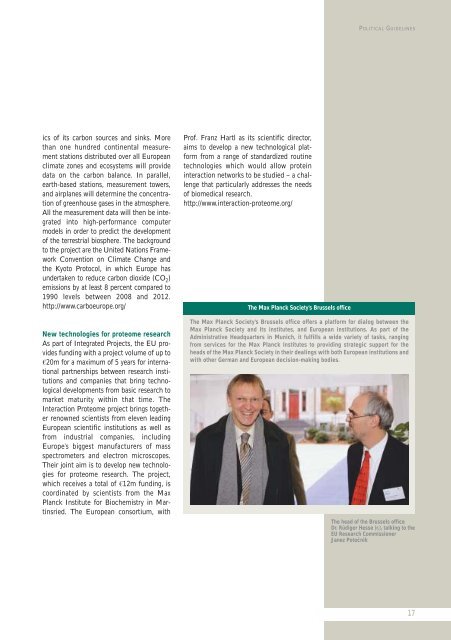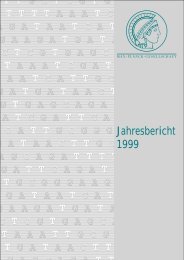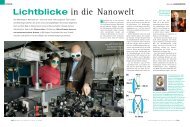Annual Report 2004 - Profil - Max-Planck-Gesellschaft
Annual Report 2004 - Profil - Max-Planck-Gesellschaft
Annual Report 2004 - Profil - Max-Planck-Gesellschaft
You also want an ePaper? Increase the reach of your titles
YUMPU automatically turns print PDFs into web optimized ePapers that Google loves.
P OLITICAL G UIDELINESics of its carbon sources and sinks. Morethan one hundred continental measurementstations distributed over all Europeanclimate zones and ecosystems will providedata on the carbon balance. In parallel,earth-based stations, measurement towers,and airplanes will determine the concentrationof greenhouse gases in the atmosphere.All the measurement data will then be integratedinto high-performance computermodels in order to predict the developmentof the terrestrial biosphere. The backgroundto the project are the United Nations FrameworkConvention on Climate Change andthe Kyoto Protocol, in which Europe hasundertaken to reduce carbon dioxide (CO 2 )emissions by at least 8 percent compared to1990 levels between 2008 and 2012.http://www.carboeurope.org/New technologies for proteome researchAs part of Integrated Projects, the EU providesfunding with a project volume of up toN20m for a maximum of 5 years for internationalpartnerships between research institutionsand companies that bring technologicaldevelopments from basic research tomarket maturity within that time. TheInteraction Proteome project brings togetherrenowned scientists from eleven leadingEuropean scientific institutions as well asfrom industrial companies, includingEurope’s biggest manufacturers of massspectrometers and electron microscopes.Their joint aim is to develop new technologiesfor proteome research. The project,which receives a total of N12m funding, iscoordinated by scientists from the <strong>Max</strong><strong>Planck</strong> Institute for Biochemistry in Martinsried.The European consortium, withProf. Franz Hartl as its scientific director,aims to develop a new technological platformfrom a range of standardized routinetechnologies which would allow proteininteraction networks to be studied – a challengethat particularly addresses the needsof biomedical research.http://www.interaction-proteome.org/The <strong>Max</strong> <strong>Planck</strong> Society’s Brussels officeThe <strong>Max</strong> <strong>Planck</strong> Society’s Brussels office offers a platform for dialog between the<strong>Max</strong> <strong>Planck</strong> Society and its institutes, and European institutions. As part of theAdministrative Headquarters in Munich, it fulfills a wide variety of tasks, rangingfrom services for the <strong>Max</strong> <strong>Planck</strong> Institutes to providing strategic support for theheads of the <strong>Max</strong> <strong>Planck</strong> Society in their dealings with both European institutions andwith other German and European decision-making bodies.The head of the Brussels officeDr. Rüdiger Hesse (r.), talking to theEU Research CommissionerJanez Potočnik17









